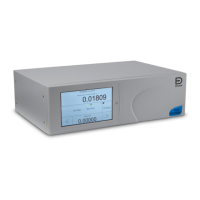Copyright 2008 Baker Hughes Company.
6 | PACE5000/6000 Instruction Manual–English
Chapter 2. Installation
For pressures less than 100 bar (1450 psi), see alternative sealing method in Figure 2-3.
Figure 2-3: Alternative Sealing Method for < 100 bar (1450 psi)
2.5 Connecting to UUT
The pressure should not exceed 1.25 x full-scale or MWP stated on the rear panel of the
instrument.
To protect the instrument from over-pressure, fit a suitable protection device such as a relief valve
or bursting disc.
1. Switch off the power supply before connecting or disconnecting the instrument.
2. Use the appropriate sealing method for all pressure connections. Refer to Section 2.4.2 on
page 5.
3. Isolate the pneumatic pressures and de-pressurize the pipes (tubes) before connecting or
disconnecting the instrument.
4. Make sure the user systems can be isolated and vented.
5. The pneumatic gas must be clean and dry, nitrogen or air. Refer to specification in the Data
Sheet.
6. Connect pressure and vacuum supplies to the SUPPLY + and SUPPLY - connection ports.
7. Connect the Unit Under Test (UUT) to the appropriate connection port.
2.6 System
The safety of any system incorporating the equipment is the responsibility of the assembler of the
system.
The instrument requires a positive pressure supply. Instruments operating in an absolute range
or negative pressure range require a vacuum supply.
A vacuum supply should be used for a fast response for instruments operating near atmospheric
pressure.
1 PACE pressure connector.
2 Bonded seal.
3 ISO228/1 G1/8 pressure connector or adaptor. For
adaptors, see
Section 2.4.1.
CAUTION Do not exceed the maximum pressures stated in the appropriate
component manual for the unit under test.
Reduce pressure at a controlled rate when venting to atmosphere.
Carefully de-pressurize all pipes (tubes) to atmospheric pressure before
disconnecting and connecting to the unit under test.

